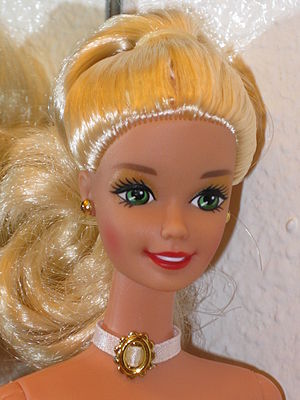
It’s always interesting to look at what keywords readers use to find us. Recently, readers were searching for the answer to the question:
What is that New Plastic Barbie Smell?
Off the top of my head, I don’t know. I haven’t been around new Barbie in almost a decade, but my guess is the plastic used in Barbie contains a vinyl that off gases. If something smells strong like chemicals, you can trust your olfactory senses to let you know it is toxic.
I found the following information on about.com:
Materials Used To Make Barbie Dolls:
Almost all Barbie dolls are made of vinyl with a soft feel to it. However, a few collector Barbie dolls have been made of porcelain, and the collector Silkstone Barbie dolls are made of a hard vinyl with a porcelain feel. Hair on Barbie dolls is generally rooted synthetic fiber.
Polyvinyl Chloride (Vinyl)
Barbie Dolls are composed of polyvinyl chloride (vinyl or PVC), a thermoplastic polymer that is mixed with a plasticizer to make the dolls more flexible and less brittle than PVC alone.
Synthetic Fiber
Barbie Dolls’ hair are made of rooted synthetic fibers that are dyed in lots to fit the specific dolls.
Elastomer
Around 2000, when Mattel decided that Barbie’s stomach needed to be more elastic and flexible, the company decided to incorporate elastomer into the mix. Elastomer allows Barbie a more realistic range of motions. Finding the correct formula for Barbie’s elastomer was difficult, because Barbies need to withstand bending, posing and even biting, since they are often playthings for young kids, according to article “Engineering Barbie” in the December 2000 issue of “Design News.” Mattel now uses an “ultra-soft” elastomer with the same softness as foam.
PBT (Engineering Thermoplastic)
Mattel also manufactures more expensive, collector’s edition Barbies that were typically made of porcelain in the past. In the early 2000s, however, Mattel switched over the PBT, an engineering thermoplastic often found in bath-ware items. Mattel’s custom formula is called “Silkstone,” and it gives Barbies a more even and lifelike complexion. Through a series of testing, engineers made a strong, durable Barbie that can undergo serious abuse, according to the “Design News” article.
Water-Based Paint
Today, Mattel crafts Barbie’s eyes with a water-based paint. Past Barbies used solvent-based paints that were not as environmentally friendly. This water-based paint is highly adhesive to most materials and takes far less time to dry than previous materials used by the company.
Well, at least the paint is “environmentally-friendly”.
PVC is very toxic. Not only should we be concerned about what this dangerous chemical does to our children, but what it does to people living around factories is deplorable. HealthyStuff.org explains:
Detection of chlorine in a toy component indicates the likely use of PVC (polyvinyl chloride) or vinyl, a widely used type of plastic. PVC is of concern to the environment and public health during all phases of its life cycle – production, use and disposal.
During the production phase, workers at PVC facilities, as well as residents in surrounding areas, may be exposed to vinyl chloride (a building block of PVC) and/or dioxin (an unwanted byproduct of PVC production), both of which are carcinogens. At the end of a product’s life, PVC can create dioxin when burned. PVC is not easily recycled.
Because PVC is an inherently brittle material, it requires additives to make it flexible and to impart other desired properties. Another group of additives commonly found in PVC products are phthalates. Phthalates are used in many plastics, especially PVC products, as a softening agent to make the plastic flexible. Over 90% of all phthalates are used in PVC products. Since 2009, childcare products (products for children under three years of age) and children’s toys (toys produced for children under twelve years of age) containing concentrations of DEHP, BBP, and DBP greater than 0.1% have been considered banned hazardous materials. DINP, DnOP (di-n-octyl), and DIDP (diisodecyl) in concentrations greater than 0.1% have been placed on a provisional ban (CPSIA 2008) unless there is a future determination of safety. This restriction does not apply to other PVC products.
The other ingredients are added to the PVC in order that it is not brittle giving the doll some flexibility.
In addition to being made of toxic materials, Barbie’s cardboard packaging is sourced in rain forests.
It’s best to avoid Barbie all together. Toxic plastic, deforestation, sexism and body image…
Ihate barbie cause they are not real
Nice post about New Plastic Barbie ,I really appreciated from it.Thanks to shared !